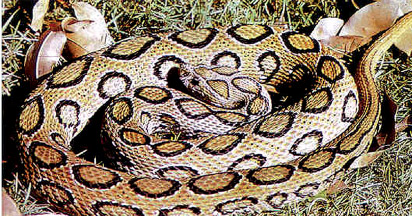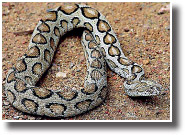 Like a sniper, the Russellís Viper
Here we produce a snake guide to identifying and protecting the Sri
Lankan Russellís viper. The guide was done in partnership of the
Wildlife Conservation Society Galle together with the American Red Cross
Disaster Preparedness Program, Sri Lanka Red Cross, World Wildlife Fund
and the Environmental Foundation Limited.
 The collaboration has spurred plenty of awareness around Sri Lanka
with workshops being conducted in highly prone snake bite areas. Target
has been primarily on medical professionals in hospitals in Anuradhapura,
Polonnaruwa, Matale, Galle and Matara districts with the assistance of
the SLRCS staff. The program is continuing with a national campaign that
will commence this month. The collaboration has spurred plenty of awareness around Sri Lanka
with workshops being conducted in highly prone snake bite areas. Target
has been primarily on medical professionals in hospitals in Anuradhapura,
Polonnaruwa, Matale, Galle and Matara districts with the assistance of
the SLRCS staff. The program is continuing with a national campaign that
will commence this month.
Russellís Viper (Daboia russelii)
Sinhala (Dharapolanga/Thith polanga)
Tamil (Kanardi viriyan)
Description: A snake with a stocky cylindrical body with a trunk that
is light brown in colour with rows of round or oval shaped brown of
yellow patches. Itís head is large and triangular and it has a clearly
defined neck.
Behaviour:
* Active during the evening and also frequently encountered at night
* Sometimes found in small bushes
* Moves with great speed when alarmed
* When provoked, it will hiss loudly and continuously, preparing to
strike
* A fully grown viper can reach a length of 80-130cm (2-4 feet)
Venom: neurotoxic (affects the nervous system), haematotoxic (affects
blood clotting) and nephrotoxic (affects kidney function)
Symptoms at bite site: Swelling and extreme pain
* Blisters may arise around the bite site, festering may occur
* Bleeding from bite wound.Symptoms of evenoming (venom entering the
body)
* Blurred vision
* Drooping eyelids
 * Possible abdominal pain * Possible abdominal pain
* Delay in blood clotting will result in loss of blood through vomit,
urine and stools
* Kidney failure
* Difficulty in breathing
What to do in case of snake bite:
1. Calm the victim and tell them that 70% of snakes who bite do not
inject venom
2. Immobilise the victim and bandage the area of the bite without
tying it too tightly
3. Get the patient to hospital as immediately as possible. The best
place would be the Toxicology Unit at the Peradeniya Hospital
4. Tell the doctor about signs and symptoms of the victim
5. Treat the patient with proper medication and snake bite
anti-venom.
|

